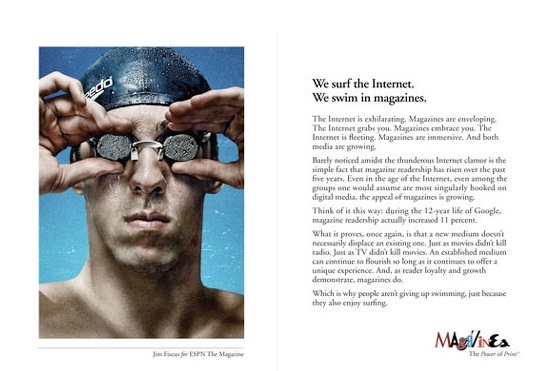NY Times media beat reporter David Carr nails it with this profile on Esquire Magazine’s harrowing tale of what it’s like to be relevant, then irrelevant, then relevant again.
Maybe all those slick ads about our visceral connection to printed magazines were on to something…

New York Times:
How Esquire Survived Publishing’s Dark Days
By David Carr
Esquire magazine, a monument to male vitality, seemed about to keel over in 2009.
Famous for laying down a much-followed literary track with an article in 1966 by Gay Talese titled “Frank Sinatra Has a Cold,” the magazine found itself gasping for breath and fighting for survival.
Amid the plague that hit the magazine industry back then, Esquire was worse off than most. Beaten up by a crop of lad magazines like Maxim, then hammered by the flight of advertisers and readers to the Web, Esquire suffered a 24.3 percent loss in advertising pages compared with 2008, which was almost as bad, by the way. A Web site for investors, 24/7 Wall Street, predicted in 2009 that Esquire would be one of “Twelve Major Brands that Will Disappear” the following year.
Worse still, guys like me who have a general interest in the general interest — politics, music, sports, and yes, good-looking women — were looking elsewhere for guidance on how to be a modern man. I didn’t fit the demo perfectly — my fashion look has been compared to a laundry basket that grew legs — but I still should have been an Esquire reader. Like so many others, however, I began assembling my own content, grabbing sports from Deadspin, political profiles from New York magazine, and music advice from sites like Pitchfork.
For long-form reading, I had a nightstand full of narrative heaves from The New Yorker, and celebrity news had become so ubiquitous that I found myself uninterested in Esquire cover articles about Angelina Jolie or Ben Affleck, no matter how good the writing was.
Though it continued to be a handsome, well-crafted magazine, amid the sparkle of all the saucy new media, Esquire began to look like your father’s Oldsmobile. And we all know what happened to that brand.
Keep reading at www.NYT.com







 See More Blogs
See More Blogs
Comments